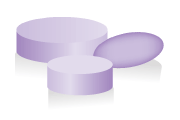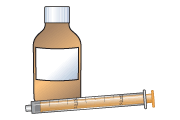Domperidone for gastro-oesophageal reflux
This leaflet is for parents and carers about how to use this medicine in children. Our information may differ from that provided by the manufacturers, because their information usually relates to adults. Read this leaflet carefully. Keep it somewhere safe so that you can read it again.
Important information about domperidone:
In April 2014, the Government body who regulate medicines in the UK – the MHRA (Medicines and Healthcare products Regulatory Agency) – released advice that domperidone should no longer be prescribed to treat conditions such as gastro-oesophageal reflux and heartburn. This is because there is a small chance that using domperidone over long periods of time can increase the risk of your child developing serious problems with their heart.
If you are reading this leaflet because your child has just been prescribed or is still using domperidone for reflux, discuss what to do with your doctor. Do not stop giving your child their medicine. If your child does have problems with their heart or you are concerned, contact your doctor, pharmacist or your local NHS services as soon as you can.
Name of medicine
Domperidone
Common brand: Motilium
Why is it important for my child to take Domperidone?
Domperidone helps to keep the entrance to the stomach properly closed, so that the stomach contents do not leak back up into the food pipe (oesophagus). Therefore, your child maybe less likely to be sick (vomit) or have reflux after a meal or feed.
What is Domperidone available as?
- Tablets: 10 mg
- Liquid medicine: 5 mg in 5 mL
When should I give Domperidone
- Give domperidone just before each main meal (if possible).
- For young babies, give domperidone four times each day. Wait at least 4 hours between doses. Give each dose just before a milk feed.
How much should I give?
Your doctor will work out the amount of Domperidone (the dose) that is right for your child. The dose will be shown on the medicine label.
It is important that you follow your doctor’s instructions about how much to give.
How should I give Domperidone?

Tablets
- Tablets should be swallowed with a glass of water, squash or juice. Your child should not chew the tablet.

Liquid medicine
- Shake the medicine well.
- Measure out the right amount using an oral syringe or a medicine spoon. You can get these from your pharmacist. Do not use a kitchen teaspoon as it will not give the right amount.
When should the medicine start working?
Domperidone works quickly to prevent vomiting with each feed or meal.
What if my child is sick (vomits)?
- If your child is sick less than 30 minutes after having a dose of Domperidone, give them the same dose again.
- If your child is sick more than 30 minutes after having a dose of Domperidone, do not give them another dose. Wait until the next normal dose.
If your child is sick again, seek advice from your family doctor, nurse, pharmacist, or hospital. They will decide what to do based on your child’s condition and the specific medicine involved.
What if I forget to give it?
If you forget to give the medicine before a meal but remember during the meal, give the missed dose. If you remember after this, do not give the missed dose.
Never give a double dose of Domperidone.
What if I give too much?
You are unlikely to do harm if you give an extra dose of Domperidone by mistake.
If you are concerned that you may have given too much, or if your child is dizzy, faints, has a dry mouth or seems unusually floppy, they may have had too much Domperidone. Contact your doctor or local NHS services (details at end of leaflet) or take your child to hospital. Take the medicine container or packaging with you, even if it is empty. This will be useful to the doctor. Have the medicine or packaging with you if you telephone for advice.
Are there any possible side effects?
We use medicines to make our children better, but sometimes they have other effects that we don’t want (side-effects).
Domperidone is generally a safe medicine and causes few side effects. The side-effects will stop when they stop taking the medicine.
Side effects you must do something about
If your child has tremor (shakiness), moves strangely or slowly, or their speech is slurred, contact your doctor straight away.
Other side-effects you need to know about
- Your child may get stomach cramps.
- Rarely it can cause problems with the heart beat (QT prolongation or abnormal heart rhythms).
Very occasionally a child may produce small amounts of milk from the nipples. Discuss this with your doctor if this happens, it maybe appropriate to stop the medicine.
There may sometimes be other side effects that are not listed above. If you notice anything unusual and are concerned, contact your doctor. You can report any suspected side effects to a UK safety scheme at mhra.gov.uk/yellowcard
Can other medicines be given at the same time as Domperidone?
- You can give your child medicines that contain paracetamol or ibuprofen, unless your doctor has told you not to.
- Tell your doctor and pharmacist if your child is taking ketoconazole (a drug that may be used to treat ringworm and other fungal infections).
Check with your doctor or pharmacist before giving any other medicines to your child. This includes herbal and complementary medicines.
Is there anything else I need to know about this medicine?
- Many parents find that caring for a baby or child with gastro-oesophageal reflux is stressful and tiring. Talk to your health visitor or doctor if you are struggling to cope.
- In April 2014, MHRA released advice that Domperidone should no longer be prescribed to treat conditions such as gastro-oesophageal reflux and heartburn. This is because there is a small chance that using Domperidone over long periods of time can increase the risk of your child developing serious problems with their heart. If you are reading this leaflet because your child has just been prescribed or is still using Domperidone for reflux, discuss what to do with your doctor. Do not stop giving your child their medicine. If your child does have problems with their heart or you are concerned, contact your doctor, pharmacist or your local NHS services as soon as you can.
General advice about medicines
- Try to give medicines at about the same times each day, to help you remember.
- Only give this medicine to your child. Never give it to anyone else, even if their condition appears to be the same, as this could do harm.
- Make sure that you always have enough medicine. Order a new prescription at least 2 weeks before you will run out.
- Make sure that the medicines you have at home have not reached the ‘use by’ date on the packaging. Give old medicines to your pharmacist to dispose of.
- If you are not sure a medicine is working, contact your doctor but continue to give the medicine as usual in the meantime. Do not give extra doses, as you may do harm.
If you think someone else may have taken the medicine by accident, contact your doctor straight away.
Where should I keep this medicine?
- Keep the medicine in a cupboard, away from heat and direct sunlight.
- It does not need to be kept in the fridge.
- Make sure that children cannot see or reach the medicine.
- Keep the medicine in the container it came in.
Who to contact for more information?
Your child’s doctor, pharmacist or health visitor will be able to give you more information about Domperidone and other medicines used to treat gastro-oesophageal reflux.
England: NHS 111
Tel 111
www.nhs.ukScotland: NHS 24
Tel 111
www.nhs24.scotNorthern Ireland: NI Direct
Wales: NHS 111 Wales
Tel 111
www.111.wales.nhs.ukLiving With Reflux
Copyright disclaimer
Version [2]. © NPPG, RCPCH and WellChild, all rights reserved. Review by February 2017.
The primary source for the information in this leaflet is the British National Formulary for Children. For details on any other sources used for this leaflet, please contact us through our website, www.medicinesforchildren.org.uk.
We take great care to make sure that the information in this leaflet is correct and up-to-date. However, medicines can be used in different ways for different patients. It is important that you ask the advice of your doctor or pharmacist if you are not sure about something. This leaflet is about the use of these medicines in the UK, and may not apply to other countries. The Royal College of Paediatrics and Child Health (RCPCH), the Neonatal and Paediatric Pharmacists Group (NPPG), WellChild and the contributors and editors cannot be held responsible for the accuracy of information, omissions of information, or any actions that may be taken as a consequence of reading this leaflet.
